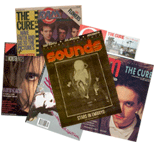July/August 1989 - Backstage (France)
(Translation below)
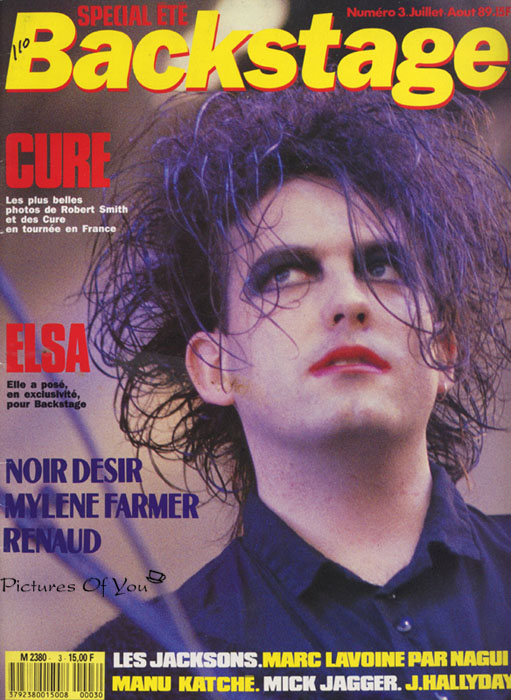
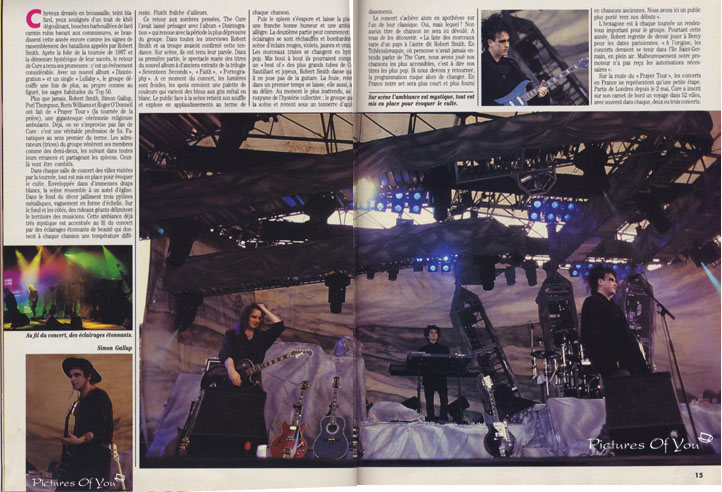
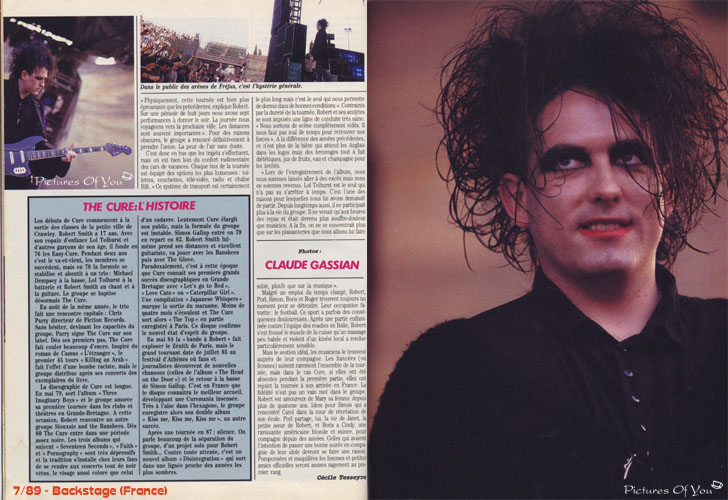
his year as well, hair dressed up in tresses,
pale faces, eyes lined with dripping eyeliner and lips colored scarlet red
running at the corners are the gathering signs of the battalions called up by
Robert Smith. After the craziness of the 1987 tour and the hysterical measure
of their success, the return of The Cure kept its promises: it is a remarkable
event. With a new album, "Disintegration", and a single, "Lullaby", the group
disarranges once again, literally and metaphorically, the sagely made up hair
of the Top 50.
More than ever, Robert Smith, Simon Gallup, Porl
Thompson, Boris Williams and Roger O'Donnell have turned the "Prayer Tour"
into a gigantic itinerant religious ceremony. Already, you can't just
"improvise" yourself into a Cure fan: it is a veritable profession of belief.
Fanatics in the purest sense of the word. The group's admirers venerate its
members like demi-gods, following their every step and sharing their
moods. They will be gratified.
In every concert venue of the cities that the
tour passes through, everything is set into place to evoke a cult atmosphere.
Shrouded in huge white sheets, the stage resembles the altar of a church. At
the back, three metallic pylons rise, vaguely recalling a stairway. Over the
back and the sides, gigantic curtains delimit the space of the musicians. This
atmosphere, already very mystical, is accentuated during the concert by
incredibly beautiful lighting that gives each songs a different note. Slightly
chilly, besides.
This return to somber thoughts was foreshadowed
by the album "Disintegration", which ties back into the darkest period of the
group. In all the interviews, Robert Smith and his team had confirmed this
direction. On stage, they kept their word. The first part of the shows
combines titles from the new record with old ones from the "Seventeen
Seconds", "Faith" and "Pornography" trilogy. At this point during the concert,
the lights are cold, the spotlights sending around a color palette from blue
to metallic grey or white. The audience in front of the stage holds their
breath and explodes into applause at the end of each song.
Later, the melancholy evaporates and gives place
to good humor and a playful atmosphere. The second half can start. The lights
have warmed up and are bombarding the stage with flashes of red, violet,
yellow and orange. The sad pieces change into pop hymns. Put back to back,
they could compose a "best of" of The Cure's most popular sing-alongs.
Skipping joyfully about the stage, Robert Smith dances when he's not playing
guitar. The crowd, until now subdued, joins in the frenzy. At the least
expected moment, when the collective hysteria reaches paroxysm, the group
leaves the stage, only to come back under a storm of applause.
The concert ends in apotheosis with one of their
classics. Yes, but which one? No, we won't give out any song titles here. It
is for you to discover. "The list of songs changes a little from country to
country", says Robert Smith. In Czechoslovakia, where no one had ever heard
The Cure, we played our most easily accessible songs, the singles. If we were
to go back, the setlist would probably change. In France our sets will be
shorter and including more old songs. We have here an audience more partial to
our beginnings."
The French hexagon is an important rendezvous
for the group on every tour. And yet, this year Robert regrets having to play
Bercy for the Paris dates. "Originally, the concerts were to take place on the
Saint-Germain island, in open air. Unfortunately our promoter wasn't able to
receive all the necessary authorizations."
On the road of the Prayer Tour, the shows in
France will be only a small step. Having left London since May 2nd, The Cure
has on its schedule a journey through 52 cities, often with two or three
concerts in one city.
"Physically, this tour has been much more
difficult than the previous ones", Robert explains. "Over a period of eight
days we had seven shows to play in the evening. During the day we would be
traveling to the next city. The distances are often significant." For obscure
reasons, the group has entirely renounced air travel. Fear of flying, most
likely.
So, it is by bus that the distances are covered,
but this is far from the level of rudimentary comfort of holiday cars. Each
bus is equipped with luxury options: toilets, beds, satellite TV, radio and
stereo hi-fi system. "This transportation system takes longer, but it's the
only one that allows us to sleep in good conditions." Constrained by the tough
schedule of the tour, Robert and his accomplices have self-imposed a healthy
line of conduct. "We get off stage entirely drained. It takes us quite a long
time to replenish our energy." Unlike the previous years, it is not beer that
awaits them backstage but healthy drinks, fruit juice, water and champagne for
the guests.
"When we were recording the album, we went
through some excesses but we came back. Lol Tolhurst was the only one who
didn't know when to stop. It's one of the reasons we asked him to leave.
He hadn't been participating in the life of group for a long time as well. He
would only show up at dinner time and had become more of a whipping boy than a
musician. At the end, we were only thinking of what jokes to play on him,
rather than the music."
Despite a very full schedule, Robert, Porl,
Simon, Boris and Roger can always find a relaxing moment. Their favorite
pastime: football. This sport has sometimes painful consequences. After a
fiery game against the crew team in Italy, Robert strained a hip muscle that
the unskillful and too strong massage given by a local physiotherapist has
made very sensitive.
But the musicians find the ideal support close
to their loved ones. The fiancées (or wives) rarely follow the whole tour, but
in the case of The Cure, if they were absent during the first part, they have
rejoined the tour since its arrival in France. Fidelity is not an empty word
for this group. Robert has been in love with his wife Mary for more than
fourteen years. Same for Simon who had met Carol back in the schoolyard. Porl
shares his life with Janet, Robert's little sister, and Boris with Cindy, a
ravishing blonde and slim American whom he has been together with for years.
Female fans who had hoped to spend a good evening in the company of their idol
will have to learn to live with it. All dressed up and pretty, the wives and
official girlfriends will be sitting quietly in the first row.
-- Cecile Tesseyre
Side-box:
The Cure: A History
The beginnings of The Cure start at the end of
the school year in the little town of Crawley. Robert Smith is 17. Together
with his childhood friend Lol Tolhurst and other boys his age, in 1976 he
founds Easy Cure. For two years it's come-and-go, the members keep changing,
but in '78 the formula settles down and ends in a trio: Michael Dempsey on
bass, Lol Tolhurst on drums and Robert Smith on vocals and guitar. The group
renames itself to The Cure.
In August of the same year, the trio has a key
encounter: Chris Parry, president of Fiction Records. Without hesitating,
sensing the potential of the group, Parry signs The Cure to his label. Since
its first steps, The Cure makes a lot of ink flow. Inspired by the Camus novel
"The Stranger", their first single "Killing An Arab" could be taken as a
racist bomb, but the group gives out copies of the book after its shows.
The Cure discography is long. May '79 sees the
release of "Three Imaginary Boys" and the group goes on its first club and
theater tour of England. With this occasion, Robert meets another group,
Siouxsie and the Banshees. From '80 The Cure enters a pretty dark period. The
three records that follow, "Seventeen Seconds", "Faith" and "Pornography" are
very depressing and the tradition is started among their fans to show up at
concerts all dressed in black, face ghostly colored. Slowly, The Cure enlarges
its audience, but the make-up of the group is unstable. Simon Gallup joins in
'79 and leaves in '82. Robert Smith himself takes his distance and, excellent
guitarist, goes to play with the Banshees and then with The Glove.
Paradoxically, it is around this time that The
Cure has its first big discographic hits in Great Britain with "Let's Go To
Bed", "The Lovecats" or "The Caterpillar". A compilation, "Japanese Whispers",
marks the end of their depression. Less than four months pass before The Cure
releases "The Top", recorded partially in Paris. This record confirms the new
state of mind of the group.
In May '84, "Robert's band" makes the Zenith in
Paris explode, but the big turning point dates from July '85 at the Athens
festival where fans and journalists discover some new songs (from the coming
album "The Head On The Door") and the return of Simon Gallup on bass. It is in
France that the album will have its greatest success, an insane Curemania
developing in its wake. At ease in the French hexagon, the group will record
here its double album "Kiss Me, Kiss Me, Kiss Me", another success.
After the 1987 tour: silence.
Much talk about the separation of the group, a solo project for Robert
Smith... Against all expectations, there is a new album, "Disintegration",
that follows in a line close to the most somber years.
THANKS to: Aria Thelmann
@ Music For Dreams for the TRANSLATION.
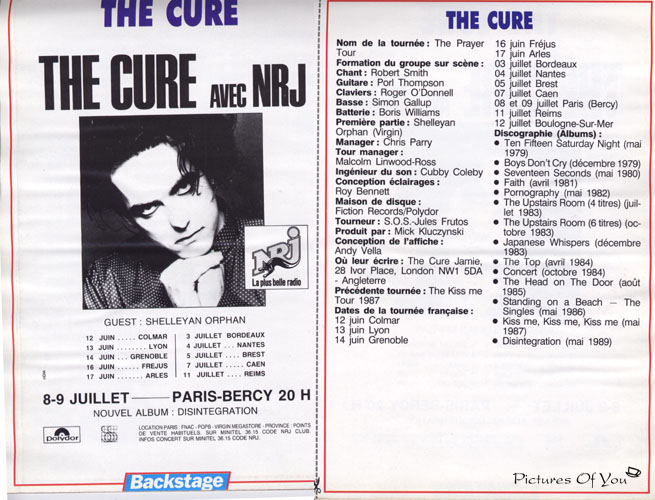
Link to more Cure Magazine covers
and articles...